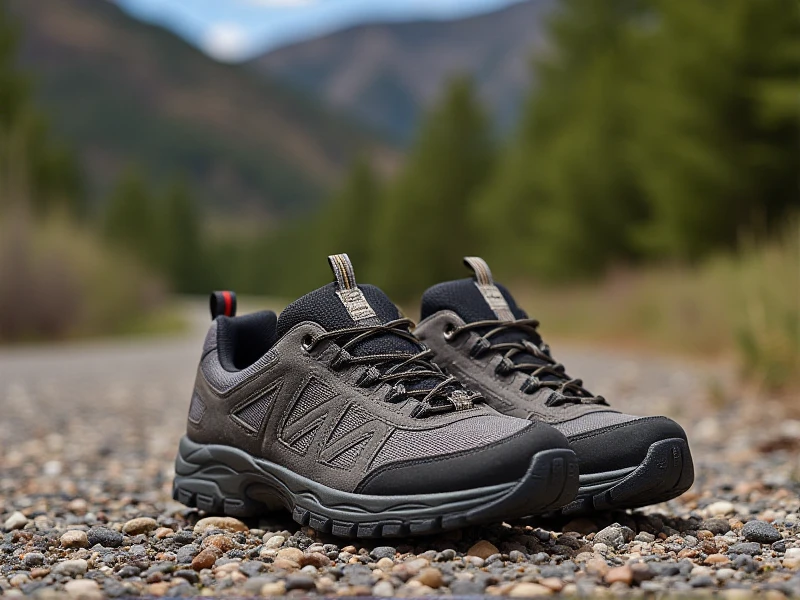The Ultimate Guide to Choosing the Best Men's Hiking Shoes
2025-06-04

Every adventure starts with the right foundation. For men hitting the trails, that foundation is a dependable pair of men's hiking shoes. Forget the blisters, the sore feet, and the slips – the right footwear transforms a grueling hike into a journey of pure enjoyment. Whether you're conquering rocky peaks or exploring wooded paths, this guide explores everything you need to know to find your perfect match.
Why Men's Hiking Shoes Matter (It's Not Just About Comfort!)
It's easy to think any old sneaker will do, but dedicated men's hiking shoes are designed for the unique demands of the trail:
1. Superior Traction: Lugs (the deep grooves on the sole) bite into dirt, mud, gravel, and rock, preventing slips and falls where regular shoes would fail.
2. Essential Ankle Support (When Needed): While low-cut options offer flexibility, many men's hiking shoes, especially mid-cut or high-cut boots, provide crucial ankle stability on uneven terrain, reducing the risk of twists and sprains – especially under a heavy pack.
3. Protection from the Elements: Robust materials and constructions shield your feet from sharp rocks, roots, brush, and often feature waterproof membranes (like Gore-Tex®) to keep feet dry in wet conditions or morning dew.
4. Underfoot Stability & Comfort: Rigid shanks in the midsole distribute weight evenly and prevent foot fatigue, crucial over long distances or rough terrain. Enhanced cushioning absorbs impact mile after mile.
5. Improved Durability: Built to withstand abrasion from rocks, dirt, and water, quality men's hiking shoes far outlast standard footwear designed for pavement.
Navigating the Types of Men's Hiking Shoes
Choosing wisely depends heavily on where you'll be hiking and your personal needs:
1. Trail Runners (Light Hiking Shoes):
Best For: Smooth, well-maintained trails, day hikes, speed over ruggedness, warm/dry weather. Ideal for experienced hikers prioritizing lightweight agility.
Features: Extremely lightweight, flexible, breathable uppers (mesh), lower ankle height, aggressive trail-specific lugs. Minimal underfoot protection and stability compared to heavier options.
2. Hiking Shoes (Low-Cut):
Best For: Day hikes, light backpacking on moderate trails, hikers seeking a blend of trail performance and comfort without bulky boots. Popular versatile choice for many.
Features: Beefed-up traction, durable uppers (often synthetic leather/nylon mesh), more robust soles than runners, better rock protection and foot support. Often waterproof options available. Provide mobility without the height of a boot.
3. Hiking Boots (Mid/High-Cut):
Best For: Rugged terrain, heavy backpacking, wet weather, demanding hikes with significant elevation change, trails littered with rocks/roots, terrain requiring superior ankle support.
Features: Strong ankle stability, heavy-duty support, maximum protection, durable construction, aggressive lugs, waterproofing standard in most models. Best weight-carrying capacity. High-cut offers the most support but is typically heaviest and less flexible.
Choosing the Perfect Pair: Fit, Feel, and Features
Selecting the right men's hiking shoes is highly individual. Follow these steps for the best fit:
1. Shop Late Afternoon: Feet naturally swell during the day.
2. Hiking Socks Are Mandatory: Wear the same sock thickness you intend to hike in. Merino wool blends are excellent for moisture management.
3. Try Before You Buy: Sizes vary significantly between brands and models. Your boot size is likely 0.5 to 1 size larger than your street shoe size.
4. Lace Up Correctly: Ensure a snug "H" lace pattern around the ankle for support without restrictive pressure.
5. Test Thoroughly: Walk on an incline/decline ramp if available. Check for heel slippage, pressure points, adequate toe room (wiggle room essential!), and overall comfort. You should NOT need to "break in" modern, well-fitting hiking shoes.
Essential Features for Modern Men's Hiking Shoes
Sole: Vibram® rubber outsoles are the gold standard for durability and grip. Deeper lugs handle mud/debris better; more closely spaced lugs are ideal for rock.
Midsole: Look for EVA or PU foam for cushioning and support. A shank (often nylon) adds structure and protects from rock bruising. Stiffer is better for heavy loads/rough terrain; softer offers more comfort on smoother trails.
Upper Material:
Leather (Nubuck/Full-Grain): Durable, abrasion-resistant, naturally water-resistant but heavier and less breathable. Requires more maintenance.
Synthetics (Nylon/Polyester Mesh): Lightweight, breathable, quick-drying. Often more affordable. Synthetics combined with leather offer a great balance ("split-grain").
Waterproofing (Breathability Trade-off): Gore-Tex® or similar membranes keep feet dry. Crucial for wet climates, crossing streams, or unpredictable weather. However, they are less breathable than non-waterproof options. Opt for mesh in consistently hot/arid environments.
Ankle Support: Choose height based on terrain and need. Low = agility; Mid/High = stability & protection on challenging ground. Weight increases with height.
Stability: Robust heels, supportive midsoles, and secure lacing systems keep the foot aligned and prevent rolling.
Weight: Lighter is generally more comfortable for long distances on easier trails. Weight builds stability and protection for tougher conditions.
Make Your Investment Last: Caring for Your Men's Hiking Shoes
Quality men's hiking shoes demand care:
1. Clean After Use: Remove dirt, mud, and debris with a soft brush, damp cloth, or specific boot cleaner. Always air dry naturally away from direct heat. NEVER put them in a clothes dryer.
2. Waterproofing Maintenance: Regularly use waterproofing treatments designed for your shoe's material (ask at outdoor retailers). This revitalizes the waterproofing barrier.
3. Avoid Excess Heat: Prolonged exposure accelerates sole breakdown and degrades adhesives and leather.
4. Store Properly: Place your men's hiking shoes in a cool, dry, ventilated area. Stuffing with newspaper after getting wet helps draw moisture and maintain shape.
Step Confidently Onto the Trail
Investing in the right pair of men's hiking shoes is an investment in your safety, comfort, and ultimately, your enjoyment of the great outdoors. By understanding the different types, prioritizing a perfect fit, and recognizing the essential features that match your activities, you can confidently find boots or shoes that feel like an extension of your feet. Forget the struggle; focus on the scenery.
What trails are calling your name? Gear up with the right men's hiking shoes and make every step feel great!
Category: